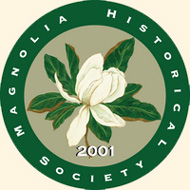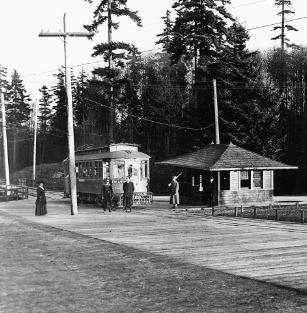Snapshot in Time
By Monica Wooton, MHS Board Member
Mimi Sheridan, MHS Board Member
Then…
50 years ago – Just as the establishment of Fort Lawton took many years of tug-a-war among various interests and individual wills, so did the undoing of it when the property and buildings were surplused in the 1960’s. This controversy pitted interests against each other about the creation of a Historic District. The proposal to preserve some of the original buildings and grounds was met with anguish by the Friends of Discovery Park and with joy by some city officials and citizens. This debate came on the heels of a long list of other debates regarding private and public interests wanting the land before and after it became Discovery Park.
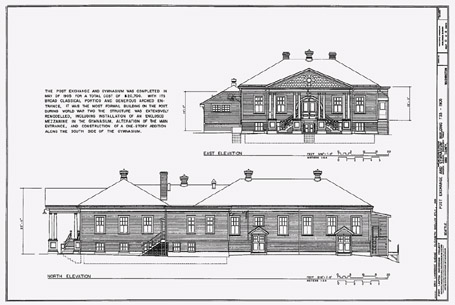
Drawings of two views of the Fort Lawton Post
Exchange and Gymnasium, which was completed in
1905 at a total cost of $20,700. This building,
which still stands on the parade grounds, is on the
National Register of Historic Places. Historic
American Buildings Survey, Fort Lawton
Recording Project, Page 12. 1981.
The Friends became staunch and unwavering defenders of not allowing this park to become another Central or Stanley Park. They continually referred back to the Discovery Park Master Plan that prescribes that the park: “…should…provide… open space of quiet and tranquility…a sanctuary…[to] escape the turmoil of the City and enjoy the rejuvenation which quiet and solitude and an intimate contact with nature can bring.”
In 1975, a proposed golf course in the Park was put to a city vote. The Friends made a compelling case against it and citizens agreed. Shortly afterwards, the City proposed that the original Army buildings be preserved in a historic district.
The Friends again contended that to keep and use historic buildings would be a breach of the Park’s Master Plan. Many others wanted to preserve the buildings as a testament to its Colonial Revival architecture and the fort’s place in history. Still, others saw the buildings as a resource for more park opportunities and re-use.
Activist Bob Kildall stated: “It would be very difficult to carry out the master plan if parts of the property are cut up as islands earmarked for other uses…and, if various buildings are used in such a way as to attract larger amounts of traffic into the Park.” Some disagreed. One proposal was for a low-income district for artists who could use the buildings as homes and studios.
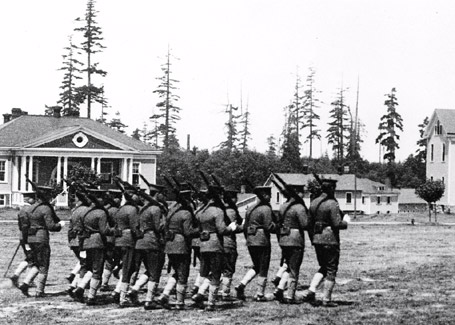
A squad of troops marching past the Post Exchange and Gymnasium
on the Fort Lawton parade ground. These soldiers are wearing the
standard service uniform issued circa 1903. Photo by Asahel Curtis.
Seattle Department of Parks and Recreation, Discovery Park Photographic
Archive, Photographer’s File #U-3, a portion of 14734. Circa 1909.
There were more ideas, debates and rebuttals. On December 1, 1975, Herb Robinson on the editorial page of the Seattle Times, called it “the long running ‘battle of Fort Lawton’ an effort that began a decade ago.” Robinson further expressed that the fight was not yet over.
Plans were proposed, studies for re-use were called for. Preservationists wanted to keep and use 24 buildings. In the meantime, one of the buildings proposed as an environmental learning center burned down under “possibly suspicious circumstances,” according to the Times on May 15, 1983.
The fight went on. On April 29, 1984 Robinson again weighed in: “…deciding what place, if any, the ancient Fort Lawton buildings have in the Park’s future has been at an impasse for far too long. While the issue was simple enough, its resolution has been stymied by a variety of factors…government bureaucrats, historic preservationists, and park purists…the prolonged pulling and tugging…is typical in the public policy arena these days…too cumbersome, too expensive and too vulnerable to political manipulation…”
But, there was more to the story. Federal law required that the Army consider impacts on historic buildings when turning over the property. In 1980, the city had signed a Memorandum of Agreement (MOA) requiring it to “take any action required to prevent further deterioration” of the historic buildings and to enact an ordinance to manage the historic district. The Washington Trust for Historic Preservation, with the National Trust for Historic Preservation, sued to enforce the agreement. In February 1988, the Federal District Court halted demolition, finding that “irreparable harm would occur if demolition of the historic buildings proceeded and the MOA remained unfulfilled. (Washington Trust for Historic Preservation v. City of Seattle, No. C87-1506C)
Council members continued to disagree. Councilmember Jim Street argued to save 6 buildings, without uses, while Councilmember Delores Sibonga wanted just 2 saved; but, with uses. On June 14, 1988, the City Council finally voted; and, in the words of a Times article of June 14, 1988: “six historic military buildings surrounding the Fort Lawton parade grounds will stand as empty-silent memorials to the old Army base.”
Now…
The historic buildings have been left to languish unused. The World War II chapel (added to the district in 2005) needs refurbishing, new paint and landscaping. The other buildings have peeling paint and need repairs. The recently surplused Officer’s Row and Non-Commissioned Officer’s houses are now also protected by local historic district status, the exteriors are being restored and will be sold to individual private owners, who will be in a homeowner’s association bound by city historic guidelines.
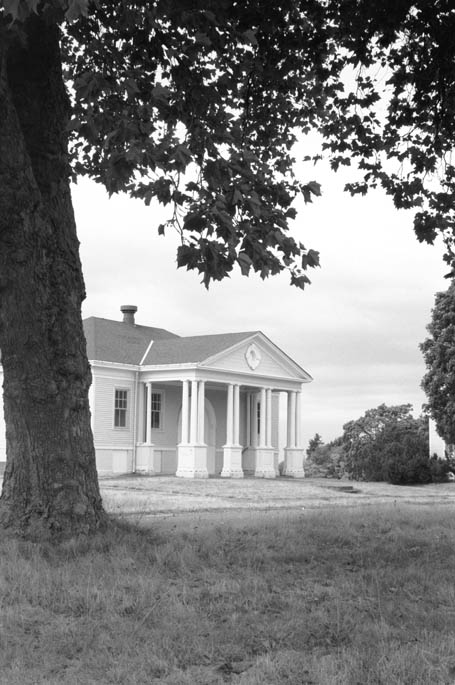
The Post Exchange and Gymnasium building remains today as
one of the Fort Lawton Historic District buildings.
Photo Monica Wooton 2000
On Thursday, April 16, the Magnolia Historical Society will hold its Annual meeting with a presentation by historian and preservationist Mimi Sheridan on the history of the Fort and the Historic District. The meeting will be held at 7 PM in the Fireside Room at Magnolia Lutheran Church (2414 31st Avenue West). THRIVE Communities will also speak about plans for the privatization, rehabilitation and restoration of Officer’s Row and the Non-Commissioned Officer’s houses in the Historic District. Sheridan did the excellent program on the history of the Magnolia Boulevard at last year’s annual meeting. This program is free to the public and refreshments will be served.
For more information on the meeting or to buy Magnolia’s award-winning history books which includes the history of the Fort and Discovery Park check out the links above.

